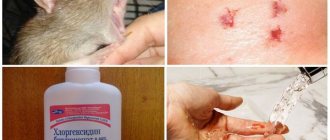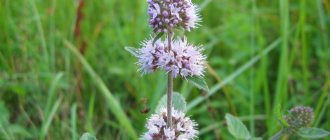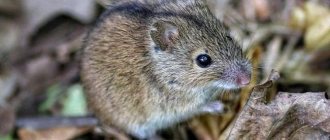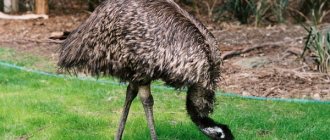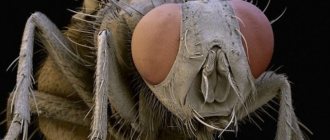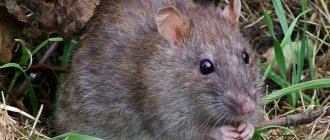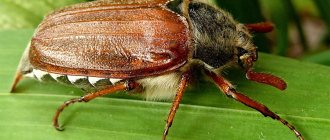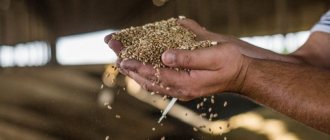In nature, there are many animal pests that prevent high yields. These include such a rodent as the water rat (the animal can also be called the water vole). The animal harms not only the seedlings, damaging them, but also steals various root crops and bulbous flowers from the beds, causing the death of fruit and berry plantations. The situation is complicated by the fact that a very active and voracious representative of wild rats reproduces very quickly. What a water rat looks like, what it eats, where it lives and how to deal with it - you will find the answers to all these questions in this article.
Habitat and lifestyle
The water vole (also called the water rat) is a rather large rodent, similar in appearance to a rat, but thicker and with a short tail.
- The body length of an adult animal reaches 15-22 centimeters,
- tail - about 8-12 centimeters, about half the length of the body.
- The fur of the animal is noteworthy - it is dark in color and very thick.
Inhabits damp and wetlands near lakes, rivers, ponds. In the warm season, it lives in burrows near the water, by the end of the season it moves to dry places closer to food sources.
If you carefully examine the photo of a water rat, it immediately becomes clear that it looks more like a hamster than its gray relative.
Quite often, having found passages and damaged plants, the owners of the plots come to the conclusion that they have moles. In fact, it is very easy to distinguish them - moles dig up heaps of earth, and a water rat can be found by plants twisted with roots.
Water voles (rats) on site can kill crops
As soon as you see an undermined dead perennial bush with damaged roots, think about it - a water vole is somewhere nearby.
Water rats are so named because they live near water and can swim. You can meet them near large streams and rivers, reservoirs and lakes with weak flowing or stagnant water and swamps. But these animals are not limited to the aquatic environment. They like to go to areas adjacent to the water, including fields, orchards and vegetable gardens.
Rats live in burrows dug underground, which are distinguished by a considerable length and a complex system of branching. Near the entrance to them, you can see heaps of soil thrown to the surface.
The offspring of the water rat is born in warm spring and summer. Pregnancy in females lasts only 20 days. During the season, each female brings from 4 to 6 litters, in which there can be from 6 to 14 babies. Rats leave burrows as soon as their weight reaches half the mass of adults. What the water rat eats is easy to guess.
- roots;
- young fruit plantations;
- berry bushes.
Young trees and shrubs attract rats with their bark and roots, which they do not mind eating. In the winter, they eat what they have stored in the summer.
Water voles live in the northern part of Eurasia. The southern border of the habitat runs along the northern coast of the Mediterranean Sea, Asia Minor and Western Asia, northern regions of Mongolia and China. In Russia, it lives in the non-chernozem zone, the Stavropol Territory, the Lower Volga region and Siberia.
Description of the pest
Rodents act at night, when nothing threatens them, but especially impudent hares can be seen in the garden during the day.Hares can cause tremendous damage to trees. With their strong teeth, they gnaw at the bark of the tree so that the tree may die. The best delicacy for them is young seedlings, which, after being eaten like this, simply do not have a chance to survive. Hares, as a rule, do not touch old trees.
A metal fence is a reliable protection against hares. Its height should be at least 1.3-1.5 m, otherwise the hares will easily jump over a low fence. In addition, the fence must be carefully dug into the ground to a depth of at least 30 cm. This will protect against digging, which hares can easily carry out in the event of a hunger strike.
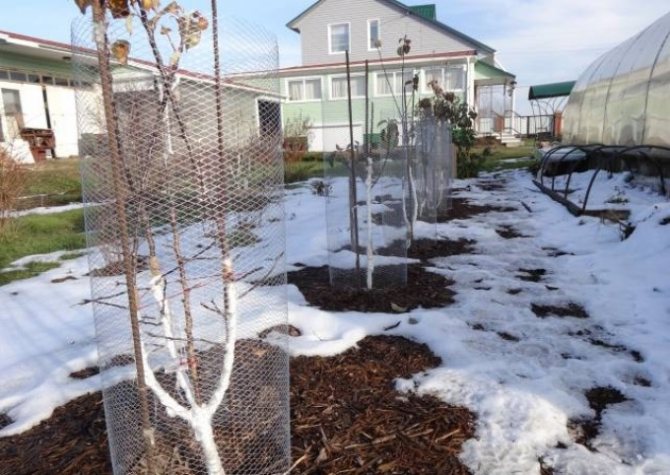
Rodent-proof tree netting
If there is no way to implement the idea with a fence, you should cover the tree trunks. To do this, use:
- Old nylon tights soaked in kerosene, gasoline.
- Thick oiled paper, and roofing felt on top.
- Plastic bottles cut lengthwise and secured around the trunks of young trees.
- Wormwood branches cover the trunk without gaps, then fasten it with a rope. Wormwood should be placed with the tails down. This plant protects the tree bark not only from hares, but also from mice.
- Coniferous branches can also be used to cover the trunk. In this case, the branches are placed in several layers, with the needles down. Several layers of spruce branches leave hares no chance to get to the bark.
Covering the tree trunk helps not only to get rid of hares, mice and other pests, but also protects the tree trunk from sunburn and frost.
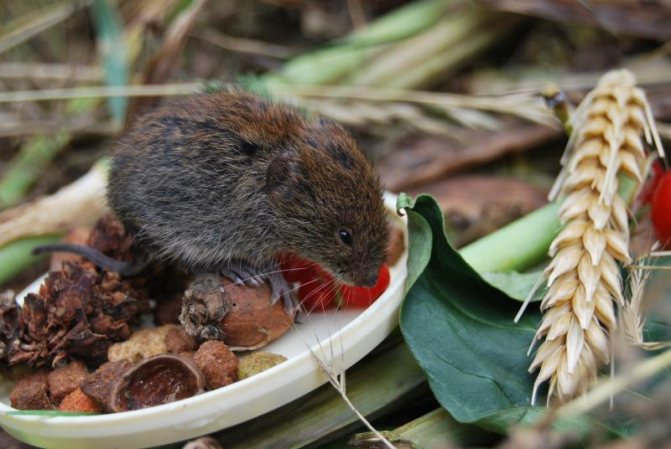

There are folk remedies that repel rodents. To make such a tool, you will need:
- 4 pods of hot pepper;
- 2 tbsp olive oil;
- Some water;
- A little dishwashing liquid.
First, grind the pepper, mix it with other ingredients and dilute with water in a 1: 8 ratio. Spray trees and the ground around them with this product. The disadvantage of this method is that after rain, the procedure must be repeated.
Another way to scare away rodents is a solution of slaked lime, cow dung and carbolic acid.
If you don't want to waste time preparing deterrent mixtures, you can buy ready-made powders and solutions. They will not harm rodents, but they will be scared away from the territory.
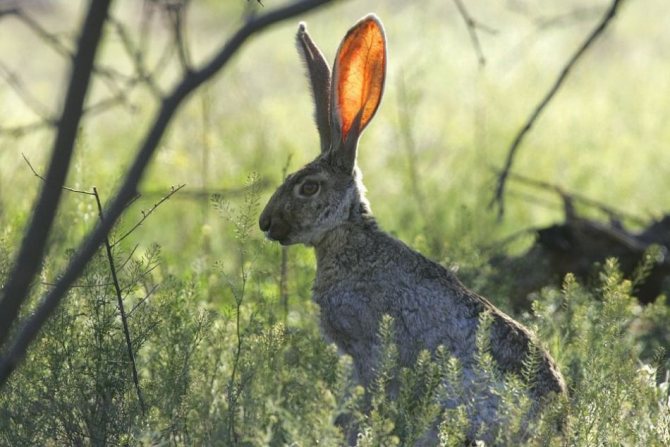

How to protect your garden from hares
Mice and rats dig holes underground for the winter. Even water rats move closer to land, hibernate in warm soil. These rodents love to build their nests in places where brushwood, foliage, and old stumps accumulate. In order not to make your site a favorable habitat for such "guests", you should carefully prepare the site for winter:
- After harvesting, they rake all the foliage and brushwood, and then burn it.
- Digging the beds.
- Trunk circles of trees and shrubs are also dug up.
- Get rid of old stumps, the remains of fallen trees.
Some gardeners use the snow trampling method. A mouse or rat will not dare to break through a dense snowdrift, so it will look for a new place to feed.
Stocks of attractive food for mice should not be left available. Often, these rodents rush the colony into the back rooms and into the house, if there are food supplies in the free access.
Protection from mice and rats can be bundles of grasses spread out on the site, which rodents do not like. If you notice that nothing is helping, and mice are still found on the site, use pesticides.
Pests on the site are an unpleasant and troublesome phenomenon. A number of complex measures help to achieve a good effect in the fight. Remember, sometimes it's easier to prevent rodents than to get rid of them later. It is unrealistic to get rid of pests forever, under favorable conditions, they can again settle in the country, in the garden, in the garden.A summer resident always needs to carefully monitor and be ready to take timely measures.
The water rat is a mammal of the hamster family. It looks like an ordinary rat, but differs from it in a more elongated body, covered with soft, smooth and silky hair. The water rat has a shorter muzzle than the common rat, crowned with short ears, and shorter legs hidden in long fur.
The water vole or ground rat, as this animal is also called, is the largest vole, only the muskrat is larger in its family. However, the body size of these rats varies significantly depending not only on geographic areas, but also on different territories included in these areas.
The water rat also differs from the muskrat in that its tail is not flat, but round in cross section, thin and not completely naked, but covered with sparse hairs and ends in a kind of brush half a centimeter long. Also, the water rat can be distinguished by its smaller eyes and yellow-brown medium incisors.
Rats weigh from 120 to 330 g with a body length of 11 to 26 cm, while the tail accounts for half or even two-thirds of the rat body length. The coat consists of a well-demarcated thin, but dense undercoat and a coarse awn. The coat color is uniform, dark brown with a slight reddishness or almost black.
Water voles continue to cause significant damage to agriculture every year. These are dangerous pests, if you have met them, you should take the fight seriously. But it will be better if you protect your site in such a way that the voles do not even have the desire to climb there. As we can see, this is quite within the power of any gardener.
We offer you to familiarize yourself with: Plants repelling mosquitoes on the site
The biological name of the rat is the water vole. It differs from the usual gray house rat in size, also large, but has a thicker constitution and a shortened tail.
Water rat (vole)
The length of the body sometimes reaches 22 cm, and the tail outgrowth is up to 12 cm, which is half of the entire rat (in a common rat, the tail is several times longer than the length of the body). The cover of the water inhabitant is thicker and has a dark gray color.
Its muzzle is flattened, while that of an ordinary land rat is more elongated. The eyes are set very close to the nose, chubby cheeks are located on the sides. In appearance, the water rat looks more like a hamster.
Where lives
In the summer, it settles on the banks of small reservoirs, but closer to autumn it moves closer to vegetable gardens, where there is a lot of food.
Many summer residents confuse the stay of rats with moles, but here there are differences: a mole digs a tunnel, and the earth piles on the soil surface in the form of a hill, a water pest digs minks, and at the location of the depression there are disfigured plants with roots turned up on the surface.
What eats
A female water vole is capable of dropping twice during the summer. Moreover, 6-10 cubs at once. Therefore, think about what kind of harvest you can expect in the fall. The water rat family feeds on meadow plants, but in the spring, while they are succulent.
Related article - How to get rid of rodents in the cellar and basement
In hot weather, the rat climbs into the garden and eats root crops and young shoots of cultivated plants. Makes supplies for the winter, it can be potatoes, carrots, beets. If the tubers are large, then the rodents eat them in the garden, and the smaller ones are dragged into the holes.
Description and features of the rodent
The underwater rat (lat.Arvicola amphibius) is a rodent from the vole family that lives over a large area. Belongs to small mammals of the order of rodents, which are ancient and extremely widespread animals. Rodents have inhabited our planet since the distant times of the Cretaceous period.Since then, the appearance of the rodent has undergone changes, the animals have adapted well to changes in the external environment. In our country, there are 11 families of the order of rodents.
A river rat is a small mammal. The animal has brown or black fur on the back and bright on the belly. The tail is crocheted and slightly hairy, the ears, nose and eyes are small. The length of the body with the head is 13-25 cm, the size of the tail is 6-15 cm.
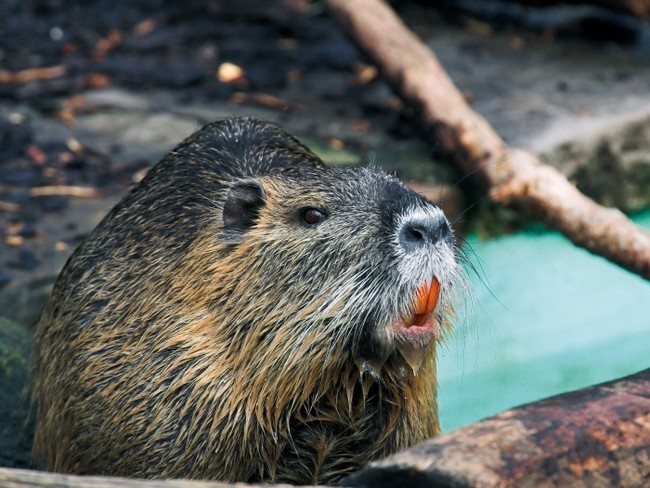

Depending on the habitat, the weight and size of the animal's body may vary. The average weight is 130-350 grams.
The main characteristics that describe the appearance of the water rat are:
- massive and awkward body;
- the third toe is longer than the others, the paws are like flippers;
- lack of hair on the back heels;
- the length of the tail is half the length of the body;
- ring scales are absent on the tail, hair is sparse;
- at the tip of the tail there is a brush measuring 0.5 cm;
- the color varies from red to black and depends on the living conditions, but does not change depending on the season;
- the fur is soft and fluffy;
- on the belly, the color of the coat is usually lighter;
- small black eyes;
- paws are poorly visible due to long hair;
- the number of teeth is 16 units.
Characteristic features of the behavior of water rats:
- the stride length is larger than that of common voles, is 7-8 cm;
- belong to waterfowl that move well and quickly in the water;
- swim long enough distances;
- get food under water;
- on land they move as fast as ordinary voles;
- way of communicating with each other: squeak;
- life expectancy: 3-4 years.
What does the water rat eat?
The rodent eats aquatic and meadow plants, from the middle of summer it begins to eat root crops. For the winter, it stores several kilograms of rhizomes and potatoes in burrows.
Rodents are happy to eat and eat up potatoes, beets, carrots. They drag small tubers into burrows and store them for the winter. Larger ones are eaten on the spot. The animals are distinguished by a good appetite, or rather, by a thorough gluttony.
Closer to spring, when all supplies are eaten up, the water rat moves to garden plots and gardens, begins to eat the roots of plants.
Reproduction
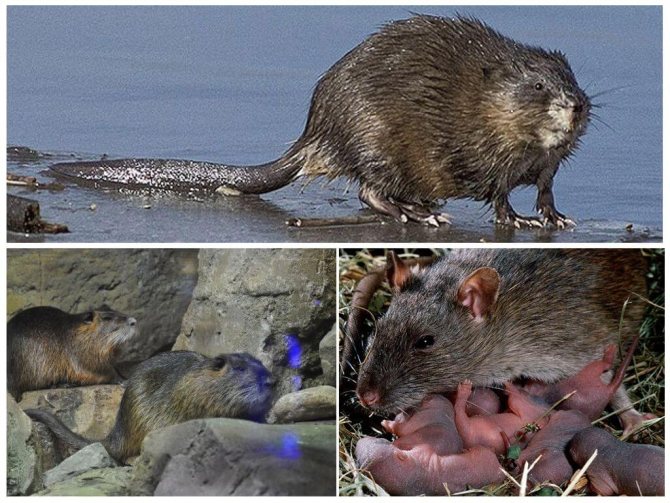

Breeding a water rat
The water rat is highly fertile. After all, females have the ability to reproduce even in the year of their birth, even before reaching the weight of adults. The first litter appears in the spring. Usually 6-7 cubs are born at a time. During the warm period, one female can hatch up to 4 rat broods.
Reviews of pest control methods
The water vole is considered a massive pest of agricultural land - pastures, hayfields, orchards and fields, as well as garden and summer cottages. Moreover, the rats inflict the most significant harm on cultivated plants in places located in the floodplains of rivers and adjacent to water bodies.
The harm caused by rats is as follows:
- In grain fields, they make holes in the ground, pull the ground to the surface and cover the ripening cereals with it, which makes it difficult to harvest.
- In vegetable fields, carrots, potatoes and beets are eaten up. Do not touch garlic and onions, legumes.
- In gardens and forestry, they gnaw on the bark of trees, from which they dry out.
- Private owners in their summer cottages spoil the harvest of vegetables and fruits.
- They also visit warehouses where finished vegetable products are stored.
We suggest you familiarize yourself with: How to get rid of mice in the ceiling of a house
But the harm caused to humans by water rats is not limited to this. They can infect people with pathogens of hemorrhagic fever, tularemia, plague, tick-borne encephalitis, leptospirosis. Therefore, the fight against these animals is carried out not only because of agricultural crops, but also for the sake of public health.
Habitat elimination
The rodent comes out of the water in places overgrown with small shrubs, littered with old trees, branches or debris - all this perfectly covers the entrances and exits of rat houses. Piled up, old plastic from a greenhouse or greenhouse is great for hiding.
Although the water rat belongs to the family of voles, it will not leave its hole and dig the network of its underground passages "out of the blue." Therefore, the first thing you need to do is tidy up the site.
The shoreline of a pond or stream must be kept clean. Take out the garbage in time, do not throw heaps of rotten grass, do not fold tree branches after the next pruning. Create conditions under which the animal will not be able to feel safe, and she will be forced to look for another habitat.
Preventive measures
In order to prevent the appearance of water rats on farmland, storage facilities and forest areas, a number of preventive measures are being taken, the purpose of which is to eliminate favorable conditions for feeding and reproduction of pests, as well as their destruction.
It includes:
- Autumn deep plowing of fields that destroys rat burrows.
- Installation of various automatic devices that prevent water rats from entering warehouses, granaries, cellars and communications in them.
- Maintaining cleanliness in the territory of these facilities.
- Cultivation of forest areas and their release from dead wood, weeds and fallen leaves.
- Preventive deratization using pesticides and mechanical traps for rats.


Such a set of measures allows you to control the number of pests and prevent them from settling in new territories. The appearance of water rats in gardens and vegetable gardens is a nuisance that can happen to those who live near various bodies of water. So that they do not damage trees and beds, all measures should be taken to ensure that pests do not penetrate the site, and if they appear, drive them out of there. Only in this case, you can count on the fact that in the fall it will be possible to collect the entire grown crop.
Practicality of the Earth Rat
Real workers, practical, disciplined people were presented in 2008. What kind of Rat is any lazy person afraid of? Of course, Zemlyanoy, because she herself does not sit idle and will not allow others. Representatives of this sign are incredibly prudent and practical. Any boss will be happy with such an employee, because few can compare in performance with the Earth Rat. She always brings the work started to the end, without being distracted by extraneous goals. The Earth Rat also has periods of stagnation, when there are no ideas, you do not want to do anything. In such situations, she just needs to overcome her inertia and move forward.


Water voles: appearance and distribution
Water voles are sometimes called water rats or mice, but, strictly speaking, they have a very indirect relationship to these rodents, despite their outward resemblance to them. These animals actually belong to the family of hamsters, although they are not very similar to the usual domestic hamsters. Water voles look about the same as ordinary voles, but they are noticeably larger. An adult can reach 15–25 cm, with the tail making up most of its length.
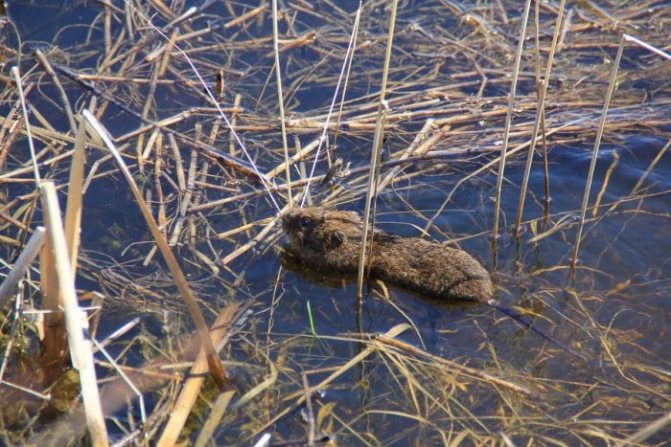

Water voles prefer to live in wetlands
This animal has thick, fluffy dark gray fur from the beginning of the short muzzle to the base of the tail, covered with hair and having a small tassel at the end.
You can meet the vole practically throughout the territory of Eurasia - up to Siberia and the North Caucasus. Most of all, she likes marshlands and the banks of water bodies, but fields, meadows and even vegetable gardens are also great for their life. These animals are very tenacious and fertile, so that nothing threatens their distribution.
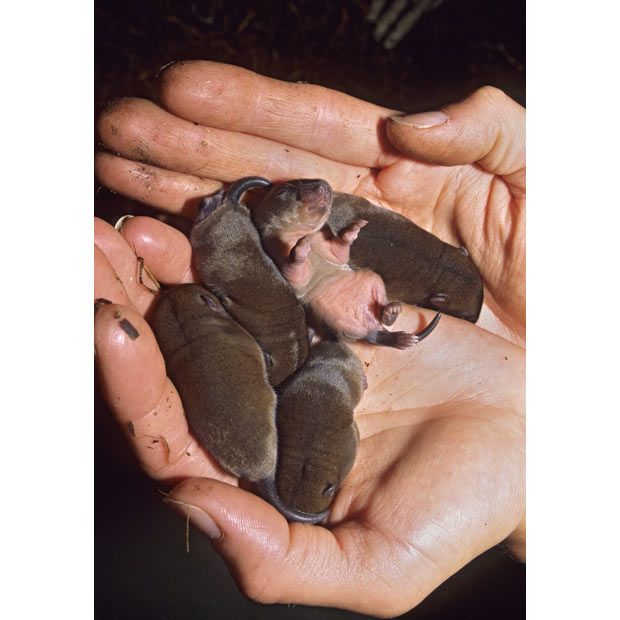

The water vole can breed up to eight times in one year.
However, the latter is hardly one of the good news - people associated with agriculture know voles firsthand and do not in vain seek to exterminate them. These rodents spoil cereal yields and gnaw at trees, causing a fair amount of damage. Voles do not attack people, and when they meet, they will most likely try to hide.
If your summer cottage is located in the countryside, especially near rivers, lakes and swamps, get ready for the appearance of intruders. Water voles, despite their name, thrive in drier areas, including on farms, vegetable warehouses, granaries, backyards and vegetable gardens.
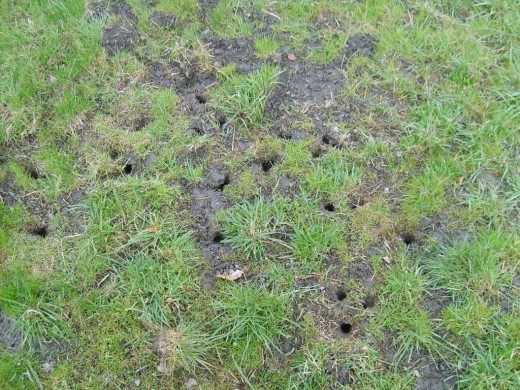

Small depressions (holes) will appear on your site if water voles start there
voles grow teeth very quickly, and in order to grind them down in a timely manner, they have to constantly gnaw on something hard. Bark seems to be the most suitable dental material for them. Naturally, trees devoid of bark subsequently die. This is exactly the fate that your apple and cherry trees can face.
Professional inclinations of Rats
Having found out, 1972 - the year of which animal, it should be noted that representatives of this eastern sign prefer to live by cunning rather than work. They achieve a lot in their lives at the expense of others who work for them by the sweat of their brow. In the worst case, Rats can be parasites or money-lenders who give money at the highest interest rates.
The safety and laziness inherent in such representatives can contribute to the fact that they become administrative workers or even succeed in politics. By the way, there are also many Rats among the successful artists.
Accumulating funds, such people spend them instantly. They never deny themselves anything. The rat can be addicted to gambling. She is a great gourmet, sensitive and sentimental.
The most suitable occupations for the Rats are financial activities, as well as the professions of a usurer, broker, detective, lawyer and writer.
Ways to combat water vole
- Tar
- Naphthalene
- Kerosene
- Calcium carbide
Soak pieces of cloth in the solution of your choice, and then bury them in the ground.


The flower hazel grouse helps in the fight against the mole
In stores with goods for the dacha, you can buy mole traps of various designs. Catching a mole into such traps is not easy. First, you need to set the trap where the mole starts to dig a course. Secondly, the mole is very smart, he has a well-developed sense of smell, he knows how to bypass traps.
For a trap or trap to work, you must do the following:
- Find the main move first.
- Dig a hole out of this stroke.
- Make a hole 1 m from the hole in which to place the trap.
- The trap should be covered with earth.
Thus, a draft will appear in the mole's hole, which the animal does not like. Soon the mole will come to patch up the hole and fall into the trap. A correctly placed trap can be triggered within 1 hour.
The dog is another reliable way to catch a mole. Having sensed the location of the animal, the dog begins to dig the ground, and itself gets the mole.
Some summer residents resort to the most cruel measures if they cannot get the mole out in humane ways. Seeing a fresh mound of earth, they dig a hole and pour water from a watering hose under great pressure. The mole, sensing danger, gets out.
The best way to protect the site is not to fight the mole, but to prevent it from entering the site. If you saw a mole's burrows in neighboring areas, but you haven't found it yet, it's time to start taking precautionary measures. To do this, you can dig a fine metal mesh around the perimeter of the plot or garden to a depth of 0.5 m.
It should be understood that the mole does not hibernate, so it can appear on your site at any time.
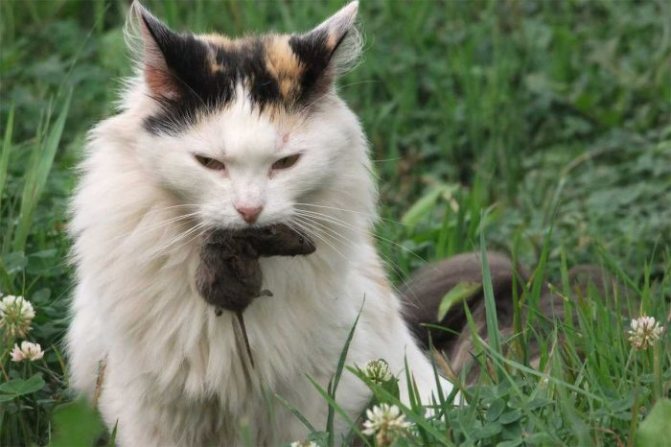

Mouse cats (especially tricolor cats) are considered the best vole hunters.
But what if the pet is not interested in hunting or you don't have one at all?
One of the most popular and affordable options is to use pesticides against voles, and together with these rodents, poison others. Generally, manufacturers produce generic rodenticides. It is very simple to use them: just buy in a store and act strictly in accordance with the instructions.
There is another option for using chemicals. In the spring, you can lay out poison-treated cotton wool or dry grass near the holes. Voles drag it to their dwellings to arrange the "interior", while the poisoned dust gets on the pests' wool, after which it licks off with them.
Gardeners reviews
Marianne
“It is very difficult to fight them and it is desirable for all neighbors at once. Various baits do not always work, and other animals and even birds may suffer. So far, gardeners call the two most effective ways. The first is to get a dog that will surely survive from the site of such a restless neighbor. The cat is also not bad, but not everyone can cope with such a large and aggressive animal. And it was also noticed that these rodents prefer quiet areas, where a person appears infrequently. He prefers to leave the noisy and restless. "
Irina
“I saw a video where a vibrator for concrete was lowered into the hole. The author argued that the effect on moles and mice is like putting an ear to a wall in which a hole is punched with a puncher, and that he got rid of all the underground inhabitants for five years. It is a pity that not everyone has this mechanism on the farm))) "
Prevention of the appearance
Now you know many means of fighting voles, but it would be best if they did not appear in your garden at all, right? There are a number of specific preventive measures that should be taken to achieve this:
- Harvest. It should be carried out in a timely and thorough manner: the beds should not contain any remnants of vegetables and root crops, spoiled fruits and tops. All this must either be thrown away or buried in compost.
- Plant processing. To prevent damage to the trunks of garden trees, coat them with a solution of lime and copper sulfate. You can also build a protective "belt" for them from roofing material, plastic or branches of thorny plants.
- Digging. In the fall, when you close the summer cottage, be sure to dig deep into the beds. This will help the earth to rest, and destroy the burrows of rodents, and destroy some insect pests.
- Cleanliness and tidiness. Take care of your garden plot. Make sure that weeds, dead leaves, carrion and other organic waste do not accumulate in the beds and under trees. Put it all in compost, for which be sure to set aside a fenced area somewhere in the far corner. In addition, the remnants of grass and tops should not be deposited in the boundaries;
- Cats. Even if your cat is a lazy fat man who doesn't care about mice, his smell can scare off voles. Let your pet run around the garden. If you don't have a cat, you can mimic its presence by scattering cat litter around the area. This product is saturated with a subtle odor, which rodents will also perceive as an alarm signal.
Traps
If the population is small, use traps. When choosing a device, give preference to ferret or mink traps. These designs are strong enough and are designed for animals with good fur, which protects the animal well.
You need to set the trap in the immediate vicinity of the burrow. Wear gloves - this will protect your hands and help to hide the "human" odor. As a bait, put the rats' favorite vegetables - potatoes, carrots, beets - into the trap.












